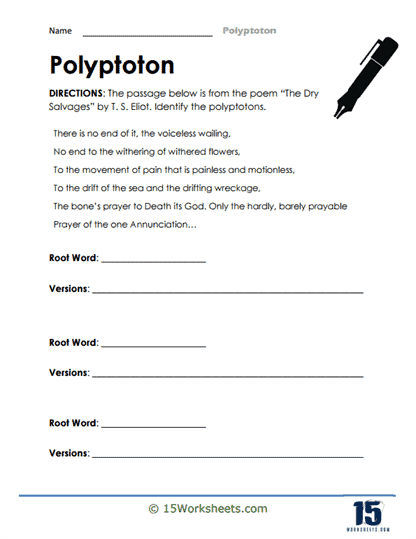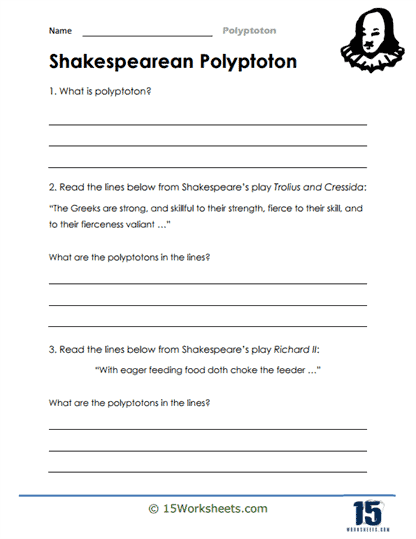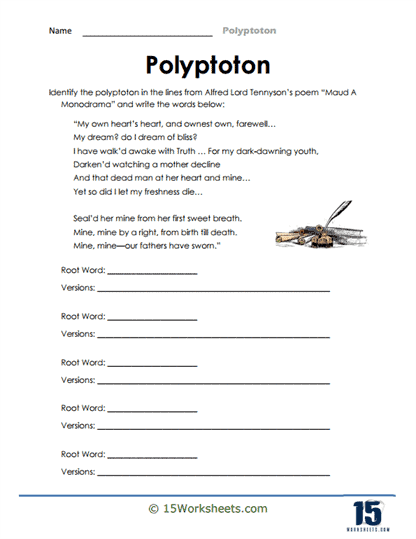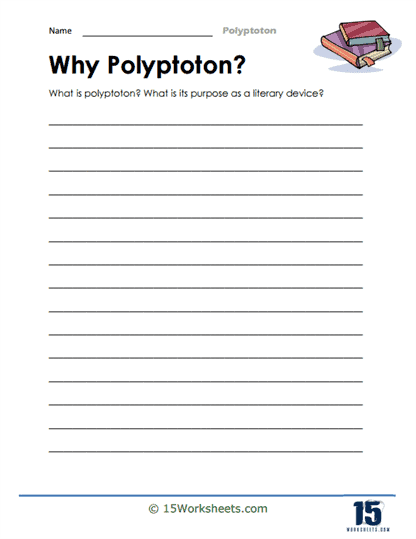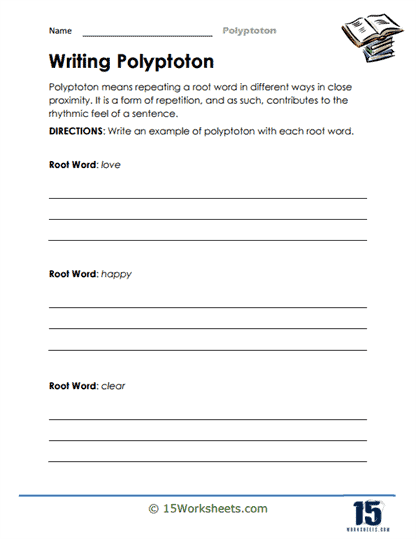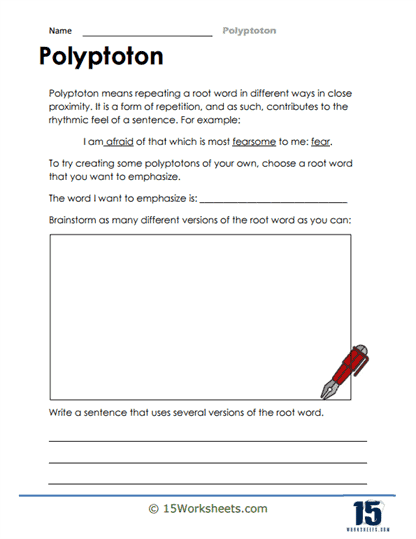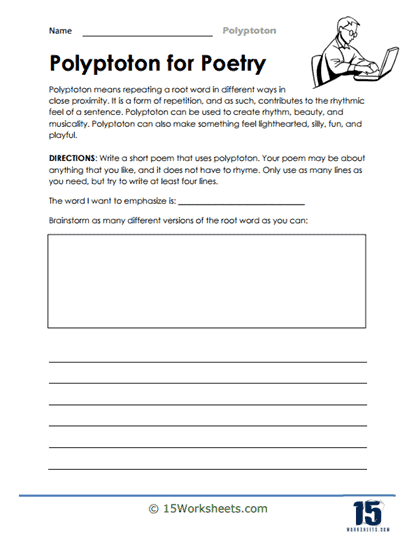Polyptoton Worksheets
About These 15 Worksheets
Polyptoton worksheets are educational resources designed to enhance students’ language arts and reading skills by focusing on the concept of polyptoton, a rhetorical and stylistic device. Polyptoton involves the repetition of a root word in different forms within the same sentence or a close succession of sentences. This can include different cases, numbers, genders, or verb forms. Such worksheets aim to deepen the understanding of language nuances, enrich vocabulary, and improve both written and verbal expression. Below, we’ll explore what these worksheets entail, the types of exercises they include, and how they contribute to language arts proficiency.
Before diving into the specifics of the worksheets, it’s important to grasp the essence of polyptoton. Polyptoton is a figure of speech where a word is repeated in different forms within the same passage. For instance, in the sentence “Love is an unloved feeling,” the word “love” appears in both its noun and adjective forms. This technique draws attention to the word, emphasizing its significance and expanding its meaning within the context.
Through a variety of exercises, these worksheets not only teach students about an important literary device but also foster a deeper appreciation and understanding of language. By incorporating polyptoton into their skill set, students become more versatile readers and writers, capable of navigating the complexities of language with confidence and creativity.
Types of Exercises
Polyptoton worksheets encompass a variety of exercises, each designed to target different aspects of language learning. These exercises include:
Identification – Students are provided with passages or sentences and are asked to identify instances of polyptoton. This foundational activity helps students recognize polyptoton in text, enhancing their analytical reading skills. Passages rich in polyptoton are provided for analysis, with questions focusing on how the device affects interpretation and understanding. This bolsters reading comprehension and interpretative abilities.
Creation – Here, learners are tasked with creating their own sentences or short paragraphs using polyptoton. This encourages creativity, deepens their understanding of word forms, and improves their ability to use the device effectively.
Transformation – These activities require students to take a sentence without polyptoton and rewrite it to include the device. This not only reinforces their understanding of polyptoton but also aids in recognizing the flexibility and multiple forms of words. Students compare sentences with and without polyptoton, discussing the impact of the device on meaning, emphasis, and reader engagement. This enhances critical thinking and analytical skills.
Contextual Use – In these exercises, learners are given scenarios or themes and are asked to use polyptoton to write a brief narrative or description. This helps integrate polyptoton into broader writing skills, showing its utility in diverse writing contexts.
Vocabulary Expansion – Focusing on synonyms and antonyms, these exercises encourage the use of polyptoton with words of similar or opposite meanings to enhance vocabulary and understand nuances in language.
Benefits of These Worksheets
Practicing with polyptoton worksheets offers numerous benefits to students, significantly enhancing their language arts and reading skills:
Enhanced Vocabulary – By working with different forms of the same word, students expand their vocabulary and become more adept at using words in various contexts. Working with polyptoton deepens students’ understanding of the nuances of language, including how subtle changes in word form can alter meaning and tone.
Improved Writing Skills – Learning to use polyptoton can add depth and emphasis to writing, making it more engaging and expressive. This skill is especially beneficial in creative and persuasive writing. Learning about and recognizing rhetorical devices like polyptoton can make reading more engaging, as students learn to appreciate the craft behind their favorite works.
Increased Reading Comprehension – Exposure to polyptoton in reading materials improves students’ ability to understand and interpret nuanced texts, enhancing overall comprehension. Identifying and analyzing polyptoton in texts fosters critical thinking and analytical skills, enabling students to dissect and understand complex literary devices and techniques. Creating sentences and narratives using polyptoton encourages creativity, pushing students to think outside the box and experiment with language in new ways.
What is the Literary Device of Polyptoton?
The literary device of polyptoton is a nuanced and powerful tool in the arsenal of authors and poets, used to add depth, emphasis, and stylistic flair to their writings. This rhetorical technique involves the repetition of a root word in multiple forms within the same sentence or in close succession, leveraging different grammatical or morphological variations. By playing with cases, numbers, genders, verb forms, or other derivatives, polyptoton enriches the text, making it more dynamic and resonant. Understanding the defining features, characteristics, and the impact of polyptoton on readers offers insights into its significance in literary works.
Defining Features of Polyptoton
The main defining feature of polyptoton is the repetition of a word with the same root but in different forms. Unlike other literary devices that might rely on sound (alliteration, assonance) or repetition of the exact word (anaphora), polyptoton’s uniqueness lies in its emphasis on morphological variance, showcasing the flexibility and depth of language.
Polyptoton is characterized by several key elements:
Morphological Variation – The repeated words undergo a change in form to exhibit different grammatical categories such as tense, case, number, or voice, highlighting the word’s versatility.
Semantic Emphasis – Through repetition, the significance of the root word is magnified, drawing the reader’s attention to its thematic or symbolic importance.
Stylistic Diversity – Polyptoton can be used for various purposes, such as emphasizing a point, creating a poetic effect, or enhancing rhythmic patterns in the text.
Cognitive Engagement – This device engages readers by making them more cognizant of the language and its possibilities, encouraging a deeper processing of the text.
Examples of Polyptoton in Literature
Three examples from literature illustrate the use and effect of polyptoton:
William Shakespeare’s “Julius Caesar” – In Mark Antony’s speech, he uses polyptoton with the phrase “with the most noble blood of all this world Here, the repetition of “noble” in different forms serves to underscore the gravity and irony of Caesar’s death, as well as the betrayal by those he considered noble. This use of polyptoton not only highlights the thematic conflict of nobility versus betrayal but also adds a rhythmic and emphatic element to Antony’s speech, enhancing its persuasive power.
John Milton’s “Paradise Lost” – Milton frequently employs polyptoton to deepen the thematic complexity and emotional intensity of his epic poem. For instance, “O miserable of happy! Is this the end Of this new glorious world…?” The repetition of “happy” in its negated form underscores the tragic irony of the fallen angels, contrasting their former happiness in Heaven with their current misery. This polyptoton accentuates the theme of loss and the drastic reversal of fortune, inviting readers to contemplate the nature of happiness and its fragility.
F. Scott Fitzgerald’s “The Great Gatsby” – Fitzgerald uses polyptoton in describing Gatsby’s dream – “His dream must have seemed so close that he could hardly fail to grasp it The repetition of “dream” in close proximity emphasizes Gatsby’s obsessive pursuit and the tantalizing nearness yet ultimate elusiveness of his aspirations. This instance of polyptoton reflects the novel’s core themes of the American Dream and the illusion of success, capturing the intensity of Gatsby’s desire and the tragic disconnect between dreams and reality.
The Effect of Polyptoton on the Reader
The use of polyptoton in literature has a multifaceted impact on the reader, affecting both their emotional engagement with the text and their cognitive processing of its content:
Enhanced Emphasis – By repeating a word in different forms, authors can spotlight key themes or concepts, making them more memorable and impactful for the reader.
Increased Depth and Complexity – Polyptoton adds layers of meaning to a text, encouraging readers to explore the nuances of language and its implications for understanding characters, themes, or narratives.
Aesthetic Pleasure – The rhythmic and phonetic qualities that polyptoton can introduce to a text enhance its musicality and overall aesthetic appeal, providing pleasure to the reader beyond the mere semantic content.
Cognitive Stimulation – Encountering polyptoton prompts readers to actively engage with the text, analyzing and interpreting the significance of the repeated word in its various forms. This active engagement deepens comprehension and retention.
Emotional Resonance – Through the emphasis and thematic depth that polyptoton contributes, readers may find the text more emotionally resonant, as they are drawn into the narrative or argument with greater intensity.



